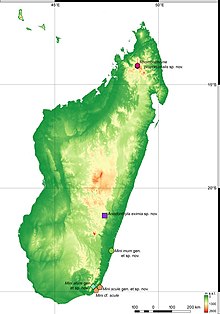
Uroplatus is a genus of geckos, commonly referred to as leaf-tail geckos or flat-tailed geckos, which are endemic to Madagascar and its coastal islands, such as Nosy Be. They are nocturnal, insectivorous lizards found exclusively in primary and secondary forest.

The Microhylidae, commonly known as narrow-mouthed frogs, are a geographically widespread family of frogs. The 683 species are in 57 genera and 11 subfamilies.

Cophylinae is a subfamily of microhylid frogs endemic to Madagascar. It has over 100 species in eight genera. Members of this subfamily range from minute to fairly large, and they are highly ecologically diverse. DNA barcode research has revealed a significant taxonomic gap in this subfamily, and an estimated 70+ candidate species were identified. Many of these have subsequently been described, as well as numerous new discoveries.

Cophyla is a genus of microhylid frogs endemic to Madagascar.

Anodonthyla is a genus of microhylid frogs endemic to Madagascar. Molecular data suggest that it is the sister taxon to all other species in the subfamily Cophylinae.

Plethodontohyla is a genus of microhylid frogs endemic to Madagascar.

Stumpffia is a genus of microhylid frogs that are endemic to Madagascar. They are mostly brown frogs that typically live among leaf litter. S. contumelia has a snout–vent length of about 8–9 mm (0.31–0.35 in), making it one of the world's smallest frogs, and several others in the genus are only slightly larger. The largest species is no more than 28 mm (1.1 in).

Mantidactylus is a frog genus in the mantellid subfamily Mantellinae. This genus is restricted to Madagascar. The genus is divided into several subgenera that form monophyletic genetic clusters and are ecologically similar.
Mantidactylus ambohimitombi is a species of frog in the family Mantellidae. It is endemic to Madagascar. Its natural habitats are subtropical or tropical moist montane forests, subtropical or tropical high-altitude grassland, and rivers. It is threatened by habitat loss.

Rhombophryne is a genus of microhylid frogs endemic to Madagascar. It is currently estimated to include more than 23 species, but only 20 of these are currently described. The common name 'diamond frog' has been proposed and used for members of this genus.

Anilany helenae is a species of frog in the microyhlid subfamily Cophylinae. It is the only species in the monotypic genus Anilany, and is endemic to central Madagascar.

The Brazilian gold frog, also known as Izecksohn's toad or flea-frog, is a very small species of frogs in the family Brachycephalidae. It is endemic to southeastern Brazil and is known from the central part of the state of Rio de Janeiro and from Serra das Torres in extreme southern Espírito Santo.

Rhombophryne serratopalpebrosa is a species of frog of the Madagascar endemic microhylid subfamily Cophylinae. Genetic evidence revealed that it is a species complex, in need of resolution. This work has made significant progress, and five related species have been described from this complex between 2014 and 2017. It is threatened by habitat loss.

Mini is a genus of small microhylid frogs that are endemic to southeastern Madagascar where they live among leaf litter in lowland forests. The three species and the genus itself were only scientifically described in 2019; although not yet rated by the IUCN, they have very small ranges and it has been recommended that two qualify as critically endangered and M. ature as data deficient.

Mini mum is a species of microhylid frog endemic to Madagascar that was described in 2019. It is the type species of its genus, Mini. The scientific name of the species refers to its size, being a pun on the word minimum: this wordplay led to the species receiving media attention when first described.

Anodonthyla eximia is a species of frog from Ranomafana in Eastern Madagascar endemic microhylid subfamily Cophylinae. It is the smallest species of the genus Anodonthyla and is the only known terrestrial member of the genus.

Andolalao Rakotoarison is a Malagasy herpetologist.
Achille Philippe Raselimanana is a Malagasy herpetologist.
Mantidactylus radaka is a species of frog in the family Mantellidae. It is endemic to Madagascar. It was described in 2020 by an international team of scientists, who differentiated it from M. guttulatus and M. grandidieri via molecular data from wild and museum specimens.

Mini scule is a species of microhylid frog endemic to Madagascar that was described in 2019. The scientific name of the species refers to its size, being a pun on the word miniscule. It measures only 8.4 to 10.8 mm in snout–vent length. It has bronze underparts with a brown groin and back of the thigh, cream upperparts with brown flecking, a dark brown side of the head, and a red iris. It is known only from the Sainte Luce Reserve, where it inhabits areas with deep leaf litter near semi-permanent water bodies. Specimens of frogs from Mandena, the Vohimena mountains, the southern Anosy Mountains, and Tsitongambarika may also be of this species. Like other species in the genus Mini, it received media attention when first described due to the wordplay in its scientific name.

















